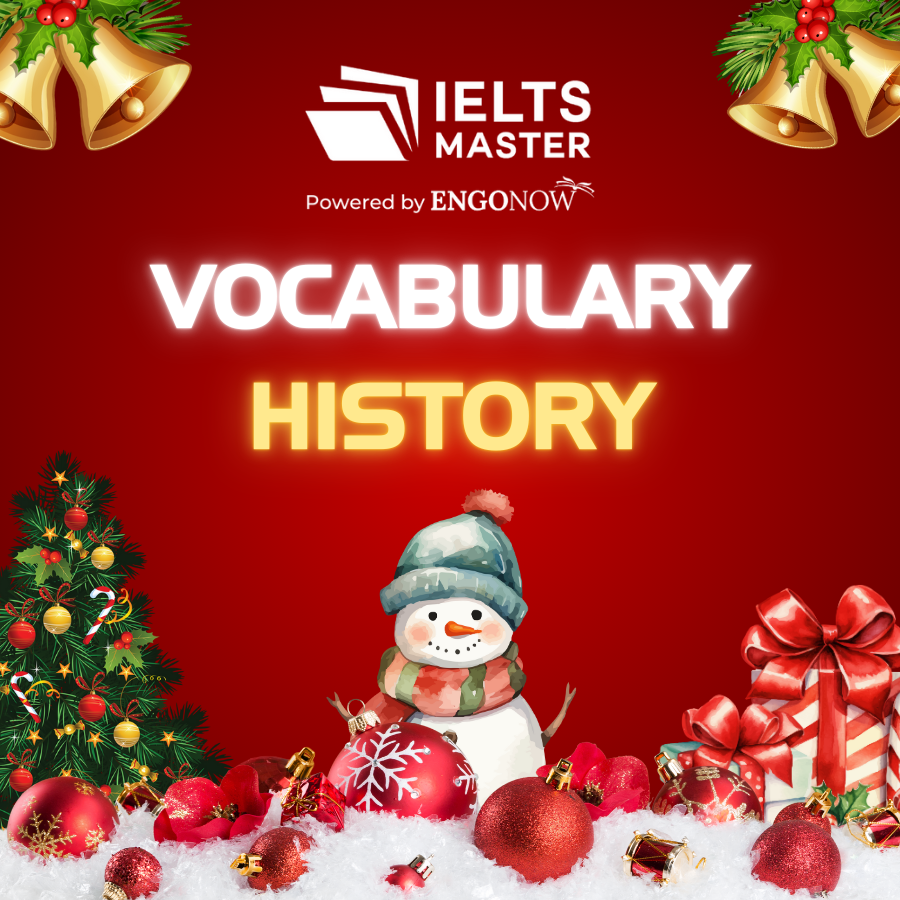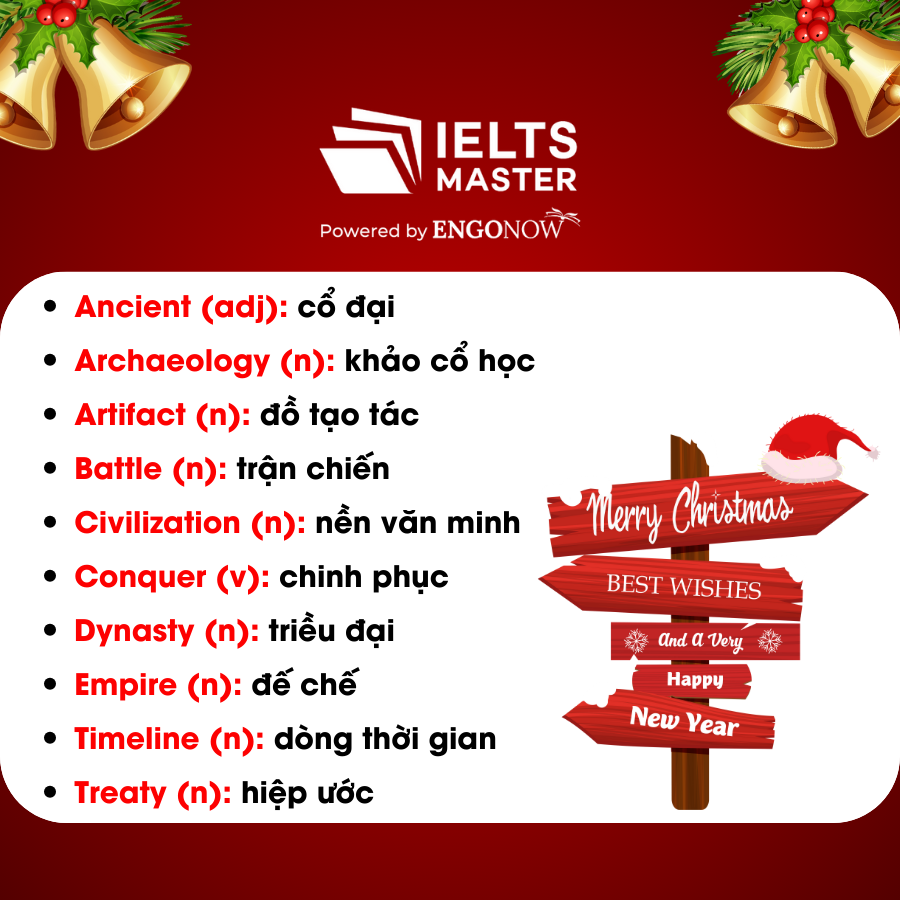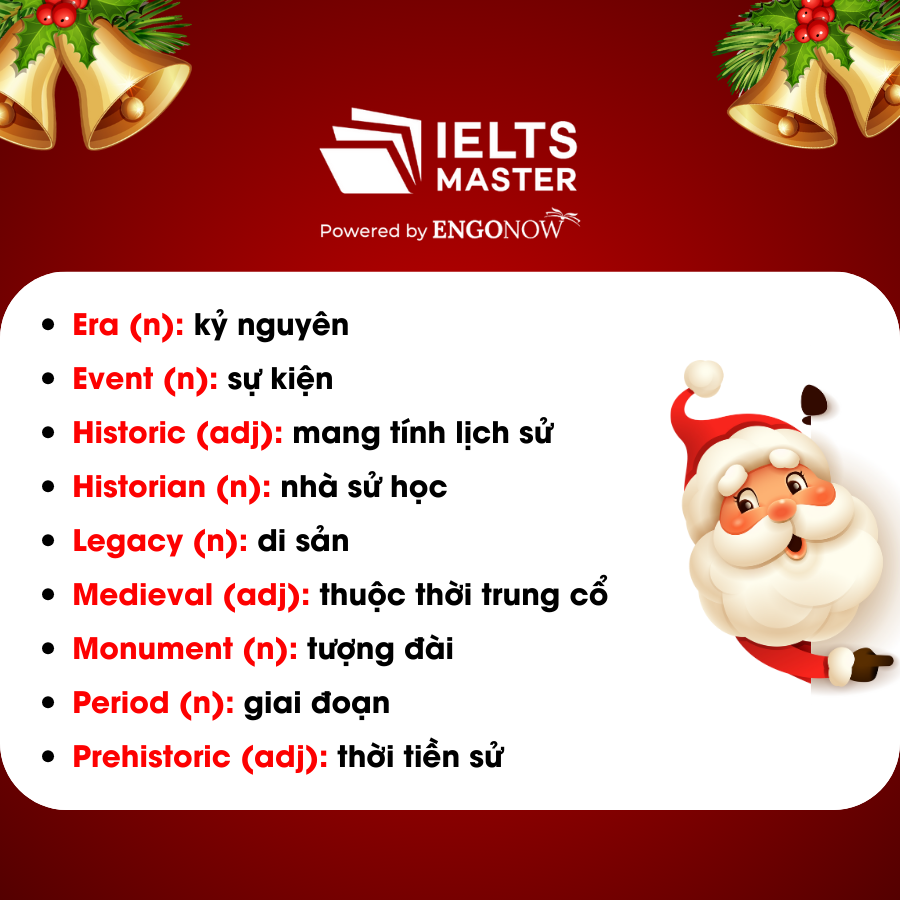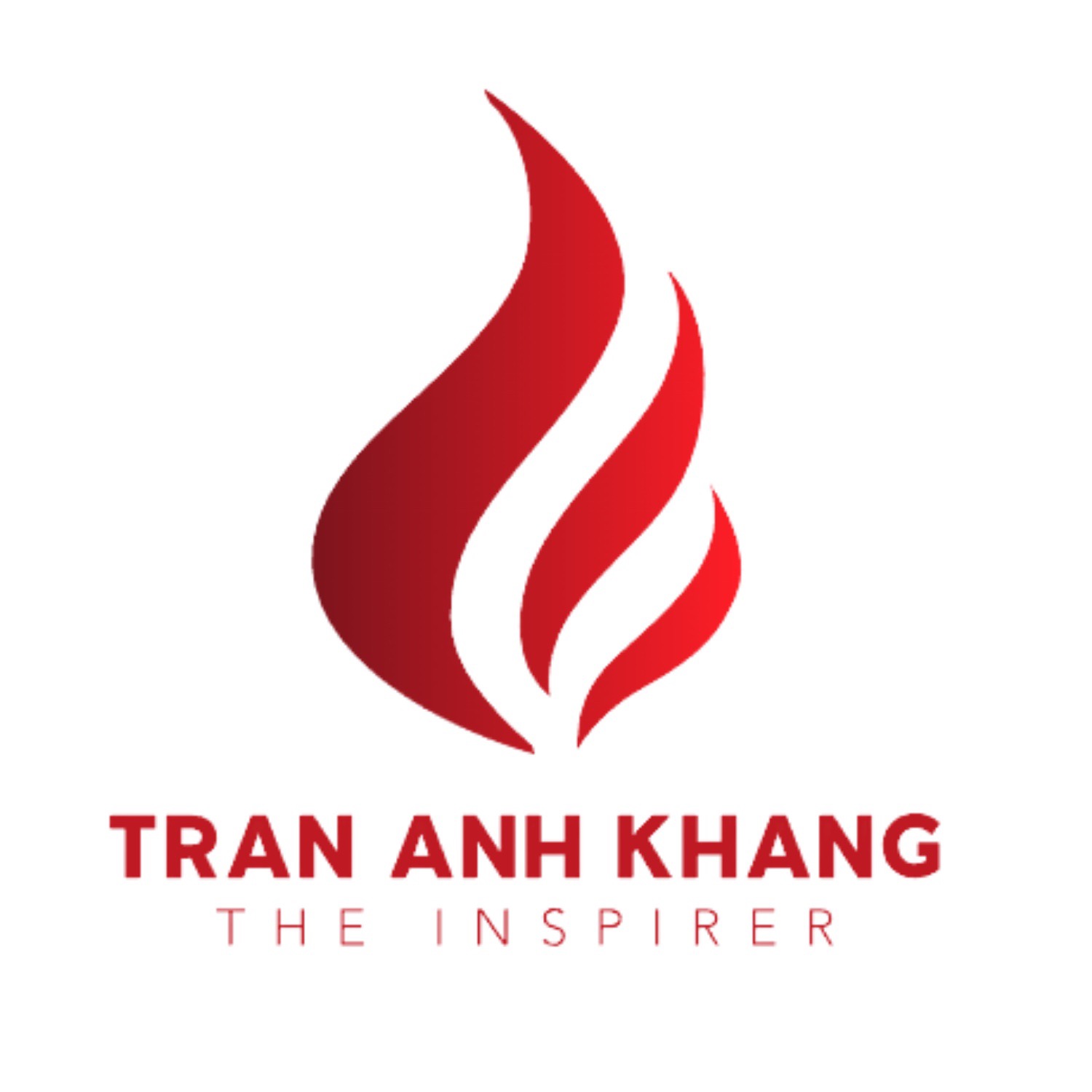
Chào các bạn, mình là Khang đến từ Trung tâm Ngoại ngữ IELTS MASTER HCM – ENGONOW. Hôm nay mình rất vui khi có thể chia sẻ đến các bạn những Vocabulary chủ đề “History”. Chúc các bạn học tốt nhé!
GIỎI TIẾNG ANH – CHUẨN IELTS – HỌC IELTS MASTER



Explanation (Giải thích)
Dưới đây là những từ vựng chủ đề “History”:
- Ancient (adj): cổ đại
- Archaeology (n): khảo cổ học
- Artifact (n): đồ tạo tác
- Battle (n): trận chiến
- Civilization (n): nền văn minh
- Conquer (v): chinh phục
- Dynasty (n): triều đại
- Empire (n): đế chế
- Timeline (n): dòng thời gian
- Treaty (n): hiệp ước
- Era (n): kỷ nguyên
- Event (n): sự kiện
- Historic (adj): mang tính lịch sử
- Historian (n): nhà sử học
- Legacy (n): di sản
- Medieval (adj): thuộc thời trung cổ
- Monument (n): tượng đài
- Period (n): giai đoạn
- Prehistoric (adj): thời tiền sử
Review (Ôn tập)
Hãy sử dụng những từ vựng chủ đề “History” này trong các câu của bạn để nhớ lâu hơn. Dưới đây là một vài câu ví dụ:
- Ancient /ˈeɪnʃənt/: Cổ đại
- Ví dụ: The pyramids of Egypt are an example of ancient architecture.
(Kim tự tháp của Ai Cập là một ví dụ về kiến trúc cổ đại.)
- Ví dụ: The pyramids of Egypt are an example of ancient architecture.
- Archaeology /ˌɑːrkiˈɒlədʒi/: Khảo cổ học
- Ví dụ: She decided to study archaeology at university to learn about ancient cultures.
(Cô ấy quyết định học khảo cổ học tại trường đại học để tìm hiểu về các nền văn hóa cổ đại.)
- Ví dụ: She decided to study archaeology at university to learn about ancient cultures.
- Artifact /ˈɑːrtɪfækt/: Đồ tạo tác
- Ví dụ: The museum has a rare artifact from the Roman Empire.
(Bảo tàng có một đồ tạo tác hiếm từ Đế chế La Mã.)
- Ví dụ: The museum has a rare artifact from the Roman Empire.
- Battle /ˈbætl/: Trận chiến
- Ví dụ: The battle of Hastings was a turning point in British history.
(Trận chiến Hastings là một bước ngoặt trong lịch sử nước Anh.)
- Ví dụ: The battle of Hastings was a turning point in British history.
- Civilization /ˌsɪvələˈzeɪʃn/: Nền văn minh
- Ví dụ: The Aztec civilization was known for its impressive temples and advanced agriculture.
(Nền văn minh Aztec nổi tiếng với các ngôi đền ấn tượng và nông nghiệp tiên tiến.)
- Ví dụ: The Aztec civilization was known for its impressive temples and advanced agriculture.
- Conquer /ˈkɒŋkər/: Chinh phục
- Ví dụ: Alexander the Great was able to conquer vast territories in Asia.
(Alexander Đại Đế đã có thể chinh phục các lãnh thổ rộng lớn ở châu Á.)
- Ví dụ: Alexander the Great was able to conquer vast territories in Asia.
- Dynasty /ˈdaɪnəsti/: Triều đại
- Ví dụ: The Tang dynasty is considered a golden age of Chinese culture.
(Triều đại nhà Đường được coi là thời kỳ hoàng kim của văn hóa Trung Quốc.)
- Ví dụ: The Tang dynasty is considered a golden age of Chinese culture.
- Empire /ˈempaɪər/: Đế chế
- Ví dụ: The Roman empire stretched across Europe, Asia, and Africa.
(Đế chế La Mã trải dài khắp châu Âu, châu Á và châu Phi.)
- Ví dụ: The Roman empire stretched across Europe, Asia, and Africa.
- Timeline /ˈtaɪmlaɪn/: Dòng thời gian
- Ví dụ: The historian created a timeline to track key events in the medieval period.
(Nhà sử học đã tạo một dòng thời gian để theo dõi các sự kiện quan trọng trong thời kỳ trung cổ.)
- Ví dụ: The historian created a timeline to track key events in the medieval period.
- Treaty /ˈtriːti/: Hiệp ước
- Ví dụ: A peace treaty was signed to end the war.
(Một hiệp ước hòa bình đã được ký để chấm dứt chiến tranh.)
- Ví dụ: A peace treaty was signed to end the war.
- Era /ˈɪərə/: Kỷ nguyên
- Ví dụ: The industrial revolution marked the beginning of a new era.
(Cuộc cách mạng công nghiệp đánh dấu sự khởi đầu của một kỷ nguyên mới.)
- Ví dụ: The industrial revolution marked the beginning of a new era.
- Event /ɪˈvent/: Sự kiện
- Ví dụ: The fall of the Berlin Wall was a significant event in modern history.
(Sự sụp đổ của Bức tường Berlin là một sự kiện quan trọng trong lịch sử hiện đại.)
- Ví dụ: The fall of the Berlin Wall was a significant event in modern history.
- Historic /hɪˈstɒrɪk/: Mang tính lịch sử
- Ví dụ: The signing of the Declaration of Independence was a historic moment.
(Việc ký Tuyên ngôn Độc lập là một khoảnh khắc mang tính lịch sử.)
- Ví dụ: The signing of the Declaration of Independence was a historic moment.
- Historian /hɪˈstɔːriən/: Nhà sử học
- Ví dụ: The historian wrote a book about ancient Egypt.
(Nhà sử học đã viết một cuốn sách về Ai Cập cổ đại.)
- Ví dụ: The historian wrote a book about ancient Egypt.
- Legacy /ˈleɡəsi/: Di sản
- Ví dụ: The pyramids are part of the legacy of ancient Egypt.
(Kim tự tháp là một phần của di sản Ai Cập cổ đại.)
- Ví dụ: The pyramids are part of the legacy of ancient Egypt.
- Medieval /ˌmediˈiːvl/: Thuộc thời trung cổ
- Ví dụ: The castle is a great example of medieval architecture.
(Lâu đài là một ví dụ tuyệt vời về kiến trúc thời trung cổ.)
- Ví dụ: The castle is a great example of medieval architecture.
- Monument /ˈmɒnjumənt/: Tượng đài
- Ví dụ: The Lincoln Memorial is a famous monument in the United States.
(Đài tưởng niệm Lincoln là một tượng đài nổi tiếng ở Hoa Kỳ.)
- Ví dụ: The Lincoln Memorial is a famous monument in the United States.
- Period /ˈpɪəriəd/: Giai đoạn
- Ví dụ: The Renaissance was an important period in European history.
(Thời kỳ Phục hưng là một giai đoạn quan trọng trong lịch sử châu Âu.)
- Ví dụ: The Renaissance was an important period in European history.
- Prehistoric /ˌpriːhɪˈstɒrɪk/: Thời tiền sử
- Ví dụ: The cave paintings are believed to be from a prehistoric period.
(Các bức tranh trong hang động được cho là thuộc thời tiền sử.)
- Ví dụ: The cave paintings are believed to be from a prehistoric period.
Exercise (Bài tập)
Hoàn thành các câu sau bằng cách sử dụng các từ trong danh sách: Ancient, Archaeology, Artifact, Battle, Civilization, Conquer, Dynasty, Empire, Timeline, Treaty, Era, Event, Historic, Historian, Legacy, Medieval, Monument, Period, Prehistoric.
- The __________ ruins of Greece are a popular tourist attraction.
- __________ is the study of human history through excavation and analysis.
- The museum displayed an ancient __________ that was discovered in Egypt.
- The __________ of Waterloo marked the end of Napoleon’s rule.
- The Mayan __________ is known for its advanced knowledge of astronomy.
- Alexander the Great is famous for his ability to __________ new territories.
- The Ming __________ in China lasted for nearly 300 years.
- The Roman __________ was one of the largest in history.
- The teacher asked us to create a __________ of key historical events.
- A peace __________ was signed to end the war.
Bạn đang tìm kiếm khóa học IELTS Bình Tân, Quận 6 chất lượng để nâng cao vốn từ vựng và tự tin chinh phục bài thi IELTS? IELTS Master Engonow tự hào là trung tâm đào tạo IELTS tiên phong ứng dụng Trí Tuệ Nhân Tạo sẽ giúp bạn hiện thực hóa mục tiêu này.
Hy vọng thông tin trên sẽ có ích cho những bạn học đang trong quá trình chinh phục IELTS. Chúc các bạn học tốt.
KHANG IELTS- TỰ HỌC IELTS THEO PHƯƠNG PHÁP ỨNG DỤNG 4.0 – CẢI THIỆN TỪ MẤT GỐC (Hotline: 0969.979.099)
Xem thêm: https://trananhkhang.com/9341/meer-len-trinh-ielts-reading-phuong-phap-den-tu-ielts-master-engonow/






